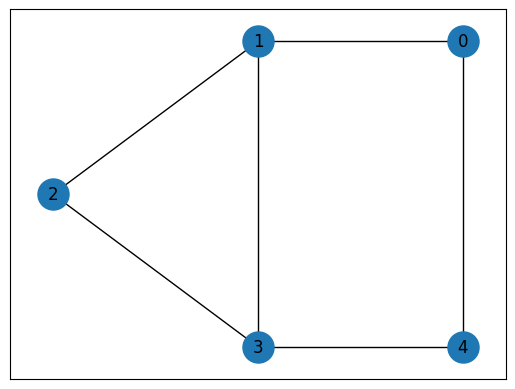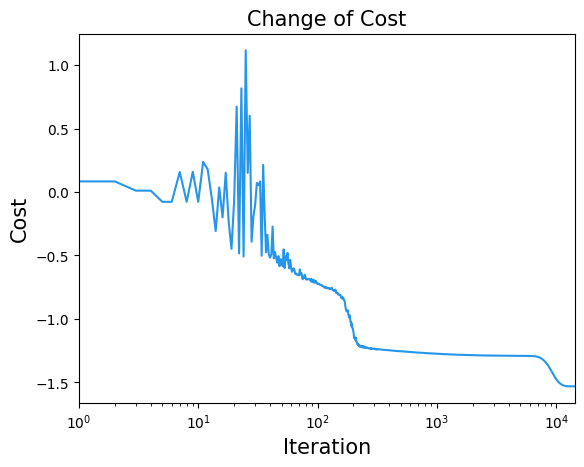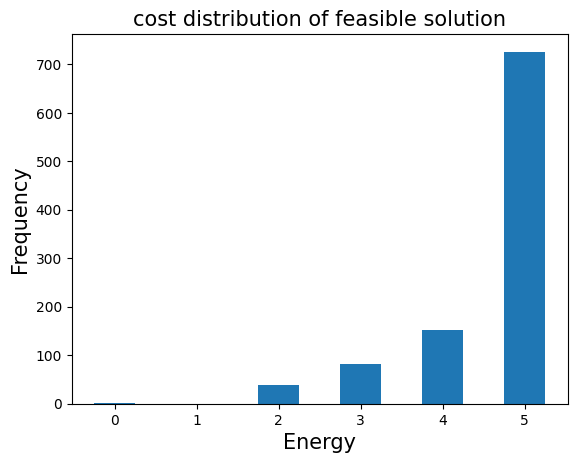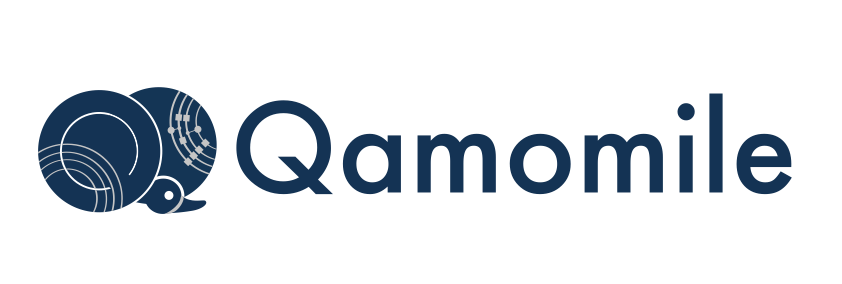# !pip install qamomile[cudaq]
Using the CUDA-Q Transpiler in Qamomile#
This tutorial demonstrates the usage of the CUDA-Q Transpiler in Qamomile and provides key examples to guide users in applying it effectively.
Translating a Hamiltonian into CUDA-Q#
We begin by defining a Hamiltonian as a test example and use our transpiler to convert it into a CUDA-Q-compatible representation. This step shows how seamlessly the Hamiltonian defined in our own library’s format can be translated into operators recognized by CUDA-Q.
import cudaq
import numpy as np
import qamomile
from qamomile.cudaq.transpiler import CudaqTranspiler
from qamomile.core.operator import Hamiltonian, X, Y, Z
from qamomile.core.circuit import QuantumCircuit as QamomileCircuit
from qamomile.core.circuit import Parameter
import jijmodeling as jm
import networkx as nx
In this snippet, we start from a custom-defined Hamiltonian using various Pauli operators (X, Y, Z) and then employ CudaqTranspiler to convert it into a format directly suitable for CUDA-Q. By inspecting ops_first_term and printing out cudaq_hamiltonian, we can verify the correctness of the translation.
hamiltonian = Hamiltonian()
hamiltonian += X(0)*Z(1)
hamiltonian += Y(0)*Y(1)*Z(2)*X(3)*X(4)
transpiler = CudaqTranspiler()
cudaq_hamiltonian = transpiler.transpile_hamiltonian(hamiltonian)
print(cudaq_hamiltonian)
(0+0i) + (1+0i) * X0Z1 + (1+0i) * Y0Y1Z2X3X4
Constructing a Parameterized Quantum Circuit#
Next, we build a parameterized quantum circuit using QamomileCircuit. We include single-qubit rotations (e.g., rx, ry, rz) and controlled variants (crx, crz, cry), as well as two-qubit entangling gates (rxx, ryy, rzz). The parameters (theta, beta, gamma) allow for flexible variational adjustments.
qc = QamomileCircuit(3)
theta = Parameter("theta")
beta = Parameter("beta")
gamma = Parameter("gamma")
qc.rx(theta, 0)
qc.ry(beta, 1)
qc.rz(gamma, 2)
qc.crx(gamma, 0 ,1)
qc.crz(theta, 1 ,2)
qc.cry(beta, 2 ,0)
qc.rxx(gamma, 0 ,1)
qc.ryy(theta, 1 ,2)
qc.rzz(beta, 2 ,0)
transpiler = CudaqTranspiler()
cudaq_qc = transpiler.transpile_circuit(qc)
Formulating the MaxCut Problem and Converting it into a Quantum Form#
In the following part, we demonstrate how to take a classical optimization problem—MaxCut—and encode it into an Ising-form Hamiltonian. We then construct a QAOA-style ansatz circuit that, when executed and optimized, attempts to solve the MaxCut instance.
def maxcut_problem() -> jm.Problem:
V = jm.Placeholder("V")
E = jm.Placeholder("E", ndim=2)
x = jm.BinaryVar("x", shape=(V,))
e = jm.Element("e", belong_to=E)
i = jm.Element("i", belong_to=V)
j = jm.Element("j", belong_to=V)
problem = jm.Problem("Maxcut", sense=jm.ProblemSense.MAXIMIZE)
si = 2 * x[e[0]] - 1
sj = 2 * x[e[1]] - 1
si.set_latex("s_{e[0]}")
sj.set_latex("s_{e[1]}")
obj = 1 / 2 * jm.sum(e, (1 - si * sj))
problem += obj
return problem
def maxcut_instance():
# Construct a simple graph for a MaxCut instance
G = nx.Graph()
G.add_nodes_from([0, 1, 2, 3, 4])
G.add_edges_from([(0, 1), (0, 4), (1, 2), (1, 3), (2, 3), (3, 4)])
E = [list(edge) for edge in G.edges]
instance_data = {"V": G.number_of_nodes(), "E": E}
pos = {0: (1, 1), 1: (0, 1), 2: (-1, 0.5), 3: (0, 0), 4: (1, 0)}
nx.draw_networkx(G, pos, node_size=500)
return instance_data
problem = maxcut_problem()
instance_data = maxcut_instance()
interpreter = jm.Interpreter(instance_data)
compiled_instance = interpreter.eval_problem(problem)
# Convert the compiled problem into a QAOA form.
qaoa_converter = qamomile.core.qaoa.QAOAConverter(compiled_instance)
qaoa_converter.ising_encode()
p = 5
qaoa_hamiltonian = qaoa_converter.get_cost_hamiltonian()
qaoa_circuit = qaoa_converter.get_qaoa_ansatz(p=p)

from qamomile.core.circuit.drawer import plot_quantum_circuit
plot_quantum_circuit(qaoa_circuit)

We have now translated the MaxCut problem into a cost Hamiltonian suitable for a QAOA-like algorithm. The parameter p determines the number of layers of problem and mixer Hamiltonians. Each layer’s parameters are variational and will be tuned to minimize the expvalue, ideally leading to a good solution to the MaxCut instance.
Transpiling and Executing the QAOA Circuit in CUDA-Q#
With the QAOA circuit and Hamiltonian defined, we use the transpiler again, this time to convert the QAOA circuit and cost Hamiltonian into CUDA-Q forms:
transpiler = CudaqTranspiler()
circ_func = transpiler.transpile_circuit(qaoa_circuit)
cudaq_hamiltonian = transpiler.transpile_hamiltonian(qaoa_hamiltonian)
cost_history = []
def objective(parameters):
expectation_value = cudaq.observe(circ_func, cudaq_hamiltonian, parameters).expectation()
cost_history.append(expectation_value)
return expectation_value
Here, circ_func is the PennyLane circuit function generated from the QAOA ansatz. Evaluating circuit(p) gives the expectation value of the cost Hamiltonian for the given set of parameters p.
Optimizing the Parameters#
Finally, we leverage CUDA-Q’s optimizers to update the parameters and attempt to find those that yield better results (e.g., lower cost for the MaxCut objective):
optimizer = cudaq.optimizers.COBYLA()
num_parameters = len(qaoa_circuit.get_parameters())
initial_parameters = np.random.uniform(-np.pi / 8, np.pi / 8, num_parameters)
optimizer.initial_parameters = initial_parameters
print("Initial parameters = ", optimizer.initial_parameters)
optimal_expectation, optimal_parameters = optimizer.optimize(dimensions=num_parameters, function=objective)
print("Optimal Parameters")
print(optimal_parameters)
Initial parameters = [-0.3592987296348616, 0.013051261183044949, 0.32491744400253264, -0.12329265025548464, 0.1116984274445526, -0.34246869847233713, -0.23762749854446114, -0.04400424673470005, -0.04984738129914362, -0.35139414506470906]
Optimal Parameters
[1.6948217996605364, 2.288032487241756, 1.0916896164440923, 0.6461590151377731, 2.4531428322653945, -0.7121704374378344, 1.0619200346348785, 0.7242215081232152, -0.5623247703260246, -0.7761463348056767]
import matplotlib.pyplot as plt
plt.title("Change of Cost", fontsize=15)
plt.xlabel("Iteration", fontsize=15)
plt.ylabel("Cost", fontsize=15)
plt.xscale("log")
plt.xlim(1, len(cost_history))
plt.plot(cost_history, label="Cost", color="#2696EB")
plt.show()

Once the optimized parameters are obtained, we use cudaq.sample to sample from the parameterized quantum circuit to get the circuit counts.
results = cudaq.sample(circ_func, optimal_parameters, shots_count=1000)
Evaluating the Results#
From the circuit_counts obtained earlier, we can transfer them to a sampleset by qaoa_converter.decode.
The sampleset can select only the feasible solutions and then we examine the distribution of the objective function values.
import matplotlib.pyplot as plt
sampleset = qaoa_converter.decode(transpiler, results)
feasible_ids = sampleset.summary.query("feasible == True").index
energies = []
frequencies = []
# Create a dictionary to group energies and count their frequencies
from collections import defaultdict
energy_freq = defaultdict(int)
for sample_id in sampleset.sample_ids:
sample = sampleset.get(sample_id)
if sample_id in feasible_ids:
energy_freq[sample.objective] += 1
energies = list(energy_freq.keys())
frequencies = list(energy_freq.values())
plt.bar(energies, frequencies, width=0.5)
plt.title("cost distribution of feasible solution", fontsize=15)
plt.ylabel("Frequency", fontsize=15)
plt.xlabel("Energy", fontsize=15)
plt.show()



